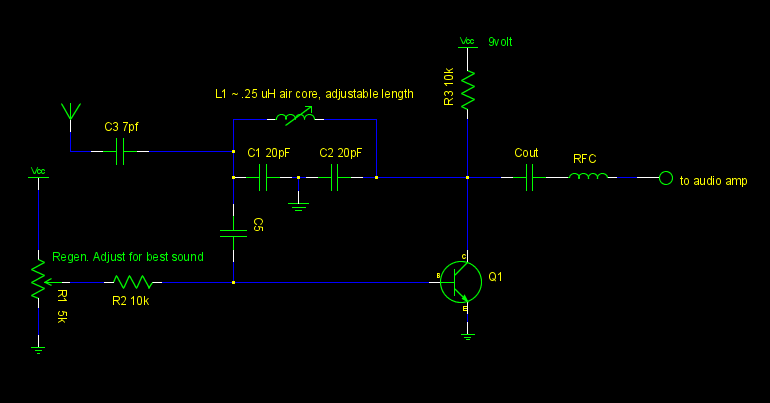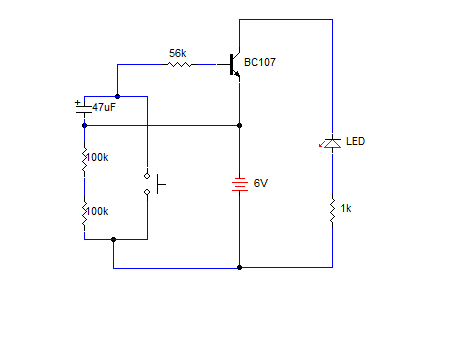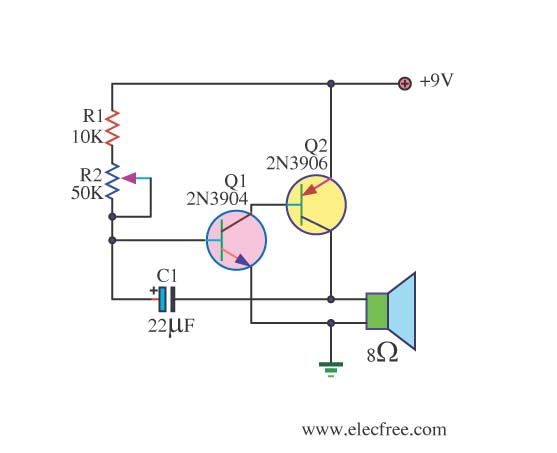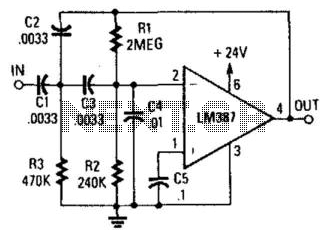
Very Simple Oscillator
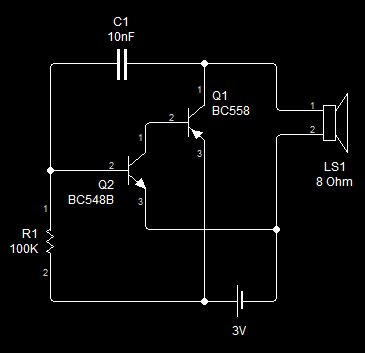
This is the first oscillator that was built. Various resources such as books, magazines, and online schematics were reviewed. Most of the designs encountered were either Colpitts or Hartley oscillators. While these designs are relatively straightforward, they require specific inductors, which may not be readily available for beginners or may be difficult to measure without the appropriate equipment. For a simpler alternative, one could consider using negistors; however, this would necessitate a higher voltage than 3V, making it impractical for portable devices unless two 9V batteries are used, which may not be cost-effective. To operate the oscillator at higher voltages, it is advisable to replace the transistors with higher power devices such as the BC337 and BD140, which can support operation up to 12V, although the BC337 may generate significant heat. The overall cost of the components is minimal, especially if a suitable speaker, switch, and button cell are already available, as these are typically the most expensive items on the list.
The described circuit is a basic oscillator design that can be constructed using readily available components. The oscillator's core functionality relies on the feedback mechanism provided by the transistors and the configuration of passive components. The circuit may utilize a transistor such as the BC337, which is an NPN transistor capable of handling moderate power levels, making it suitable for this application. To enhance the oscillator's performance and ensure stable operation, it is essential to select appropriate resistors and capacitors that define the oscillation frequency.
In this configuration, the oscillator can be powered by a 12V power supply, which can be achieved by using two 9V batteries in series. This arrangement allows for greater flexibility in component selection and enables the circuit to drive a speaker or other output devices effectively. The inclusion of a switch allows the user to turn the oscillator on and off conveniently, while a button cell may be utilized for low-power applications or as a backup power source.
When designing the circuit, careful consideration should be given to the heat dissipation of the BC337. Adequate heat sinking may be necessary to prevent thermal runaway and ensure reliable operation. Additionally, it is advisable to include bypass capacitors near the power supply connections to filter out noise and stabilize the voltage supplied to the oscillator.
Overall, this oscillator design serves as an excellent introduction to basic electronic principles and circuit design, allowing beginners to gain hands-on experience while learning about oscillation, feedback, and the behavior of transistors in electronic circuits.This is the first oscillator I ever built. I remember looking at books and magazines, schematics on the net, etc. They wereall either colpitt or hartley oscillators. Generally speaking while they`re simple enough, they require the use of properinductors which is something that usually you don`t have when you`re just starting out or you can`t measu re them because youdon`t yet own the proper equipment (unless you`re lucky). If you want something even simpler, you may take a look at negistors ” however you will need a much higher voltage than 3Vso it may not be possible to operate it in a portable device, unless you were to use two 9V batteries (and this to mewouldn`t be cheap nor practical!) If you want to operate the oscillator at higher voltages, you`ll have to replace the transistors with higher power devicessuch as the BC337 and the BD140. These should allow you to run it up to 12V (although the BC337 may run hot!) The total cost is just pennies, considering you may already have a suitable speaker, switch and button cell which arearguably the most expensive components in the list.
🔗 External reference
The described circuit is a basic oscillator design that can be constructed using readily available components. The oscillator's core functionality relies on the feedback mechanism provided by the transistors and the configuration of passive components. The circuit may utilize a transistor such as the BC337, which is an NPN transistor capable of handling moderate power levels, making it suitable for this application. To enhance the oscillator's performance and ensure stable operation, it is essential to select appropriate resistors and capacitors that define the oscillation frequency.
In this configuration, the oscillator can be powered by a 12V power supply, which can be achieved by using two 9V batteries in series. This arrangement allows for greater flexibility in component selection and enables the circuit to drive a speaker or other output devices effectively. The inclusion of a switch allows the user to turn the oscillator on and off conveniently, while a button cell may be utilized for low-power applications or as a backup power source.
When designing the circuit, careful consideration should be given to the heat dissipation of the BC337. Adequate heat sinking may be necessary to prevent thermal runaway and ensure reliable operation. Additionally, it is advisable to include bypass capacitors near the power supply connections to filter out noise and stabilize the voltage supplied to the oscillator.
Overall, this oscillator design serves as an excellent introduction to basic electronic principles and circuit design, allowing beginners to gain hands-on experience while learning about oscillation, feedback, and the behavior of transistors in electronic circuits.This is the first oscillator I ever built. I remember looking at books and magazines, schematics on the net, etc. They wereall either colpitt or hartley oscillators. Generally speaking while they`re simple enough, they require the use of properinductors which is something that usually you don`t have when you`re just starting out or you can`t measu re them because youdon`t yet own the proper equipment (unless you`re lucky). If you want something even simpler, you may take a look at negistors ” however you will need a much higher voltage than 3Vso it may not be possible to operate it in a portable device, unless you were to use two 9V batteries (and this to mewouldn`t be cheap nor practical!) If you want to operate the oscillator at higher voltages, you`ll have to replace the transistors with higher power devicessuch as the BC337 and the BD140. These should allow you to run it up to 12V (although the BC337 may run hot!) The total cost is just pennies, considering you may already have a suitable speaker, switch and button cell which arearguably the most expensive components in the list.
🔗 External reference

